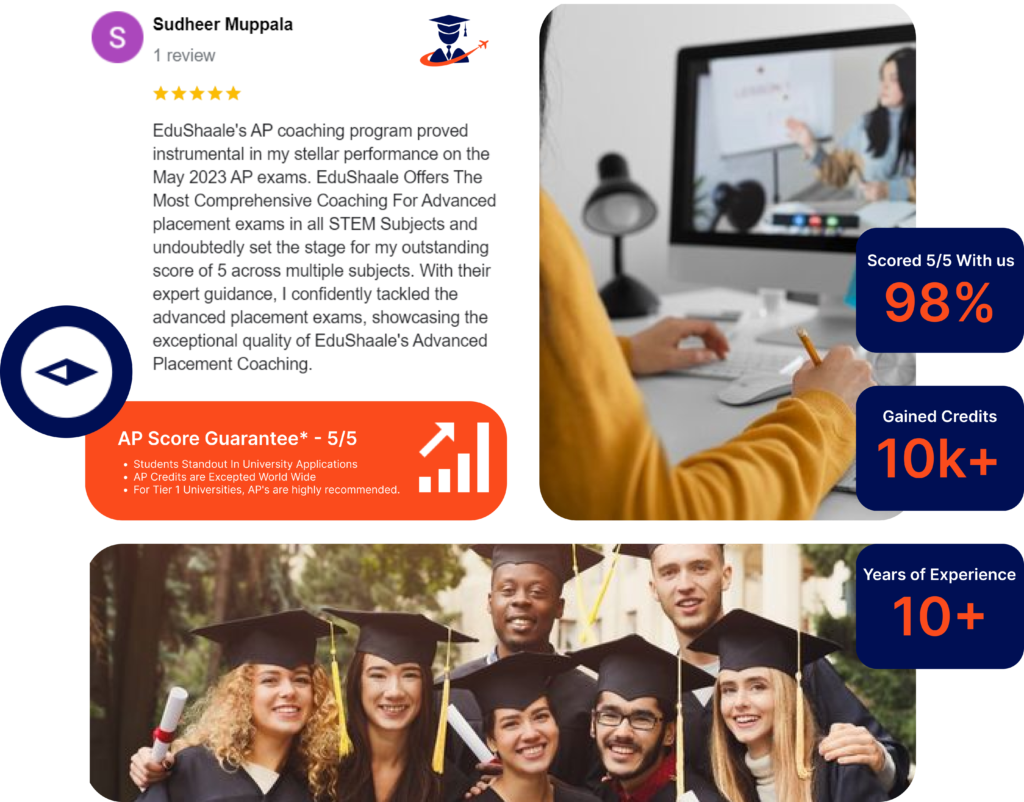AP World History: Modern Classes Online
Are you Looking for the AP World History: Modern? Worry not, EduShaale has got your back
- No credit card required
- Free Demo Session
- Personalized 1-1 Classes
- Flexibile & Affordable


AP Coaching Program
- 1-1 coaching from Certified AP Trainers per subject
- 5000+ Practice Questions and Drills
- 1000+ Question Bank
- 5+ AP Style Mock Tests
- 50+ Topic Based Tests(On Demand Generation)
- 10+ years AP Past Exam Questions
- 20K+ Trusted AP Aspirants
- Parent Connect, Progress Tracking & Regular Follow-up
- 4.9/5 Rated by AP Aspirants
A high AP score not only allows you to reduce your overall tuition fee and save time, but it also increases your chances of entrance into your dream and even allows you to be considered for scholarships.
AP World History: Modern Structure
55 questions 55mins 40% of Score
The questions in the multiple-choice section come in sets of usually 3–4 questions based on the same stimulus. The questions will include one or more sources to respond to such as primary and secondary texts, images (for example, artwork, photos, posters, cartoons), charts, and maps.
You'll be asked to:
- Analyze the provided sources
- Analyze the historical developments and processes described in the sources
3 questions 40mins 20% of Score
In the short-answer section, you’ll write answers to questions in your test booklet. Some questions include texts, images, graphs, or maps.
- Question 1 is required, includes 1 or 2 secondary sources, and focuses on historical developments or processes between the years 1200 and 2001.
- Question 2 is required, includes 1 primary source, and focuses on historical developments or processes between the years 1200 and 2001.
- You can choose between Question 3 (which focuses on the period from 1200 to 1750) and Question 4 (which focuses on the period from 1750 to 2001) for the last question. No sources are included for either Question 3 or Question 4.
You'll be asked to:
- Analyze the provided sources
- Analyze historical developments and processes described in the sources
- Put those historical developments and processes in context
- Make connections between those historical developments and processes
2 questions 1hr 40mins 40% of Score
In the free-response section, you'll write answers to questions in your test booklet. There are two questions: one document-based question and one long essay.
Document-Based Question
Recommended Time: 60 Minutes (includes 15-minute reading period) | 25% of Score
The 60-minute recommended time for this section includes a 15-minute reading period.
- You'll be presented with seven documents that give various perspectives on a historical development or process.
- You’ll be asked to develop and support an argument based on these documents and other evidence from your own knowledge.
- The topic of the document-based question will include historical developments or processes between the years 1450 and 2001.
Long Essay Question
40 Minutes | 15% of Score
- You'll have a choice of three questions; you’ll pick one to answer.
- Each tests the same skills but the questions focus on different historical time periods (either the period from c. 1200–1750, from c. 1450–1900, or from c. 1750–2001).
- You'll be asked to develop and support an argument based on evidence.
Course Content
The AP World History: Modern Exam will assess your knowledge of the historical concepts covered in the course units, as well as your ability to analyze primary and secondary sources and identify patterns and connections that can be used to support a historical interpretation.
The Global Tapestry
You’ll explore how states formed, expanded, and declined in areas of the world during the period c. 1200–c. 1450 and the related political, social, and cultural developments of that time.
Topics may include:
- States in:
- Africa
- Afro-Eurasia
- East Asia
- Europe
- South and Southeast Asia
- The Americas
- Global and regional religions and belief systems
On The Exam
8%–10% of exam score
Networks of Exchange
As you continue your study of the period c. 1200–c. 1450, you’ll learn how areas of the world were linked through trade and how these connections affected people, cultures, and environments.
Topics may include:
- The Silk Roads
- The Mongol Empire
- The Indian Ocean trading network
- The trans-Saharan trade routes
- The effects of cross-cultural interactions
On The Exam
8%–10% of exam score
Land-Based Empires
You’ll begin your study of the period c. 1450–c. 1750 with an exploration of the empires that held power over large contiguous areas of land.
Topics may include:
- The development of the Manchu, Mughal, Ottoman, and Safavid empires
- How rulers of empires maintained their power
- Religious developments in empires
On The Exam
12%–15% of exam score
Transoceanic Interconnections
Continuing your study of the period c. 1450–c. 1750, you’ll learn about advances in ocean exploration, the development of new maritime empires, and the effects of new cross-cultural encounters.
Topics may include:
- The influence of scientific learning and technological innovation
- The Columbian Exchange
- Development and expansion of maritime empires
- Internal and external challenges to state power
- Changes to social hierarchies linked to the spread of empires
On The Exam
12%–15% of exam score
Revolutions
You’ll start your study of the period c. 1750–c. 1900 by exploring the new political ideas and developments in technology that led to large-scale changes in governments, society, and economies.
Topics may include:
- The Enlightenment
- Revolutions against existing governments and the birth of new nation-states
- The Industrial Revolution
- Trade policies
- The development of industrial economies
On The Exam
12%–15% of Score
Consequences of Industrialization
You’ll continue to investigate the period c. 1750–c. 1900 and learn how the different states acquired and expanded control over colonies and territories.
Topics may include:
- State expansion in the 18th and 19th centuries
- Resistance to imperialism
- The growth of the global economy
- Economic imperialism
- Causes and effects of new migration patterns
On The Exam
12%–15% of exam score
Global Conflict
You’ll begin your study of the period c. 1900–present by learning about the global conflicts that dominated this era.
Topics may include:
- Changes in the global political order after 1900
- World War I: its causes and how it was fought
- The interwar period
- World War II: its causes and how it was fought
- Mass atrocities after 1900
On The Exam
8%–10% of exam score
Cold War and Decolonization
As you continue exploring the period c. 1900–present, you’ll learn about colonies’ pursuits of independence and the global power struggle between capitalism and communism.
Topics may include:
- The causes and effects of the Cold War
- The spread of communism
- How colonies in Asia and Africa achieved independence
- The creation of new states after decolonization
- The end of the Cold War
On The Exam
8%–10% of exam score
Globalization
You’ll continue your study of the period c. 1900–present by investigating the causes and effects of the unprecedented connectivity of the modern world.
Topics may include:
- Advances in technology and their effects
- Disease
- Environment
- Economic change
- Movements for reform
- How globalization changed culture
- New international institutions
On The Exam
8%–10% of exam score
Why us for your AP World History: Modern Classes?
At EduShaale, we take immense pride in our commitment to providing a truly personalized and 1:1 learning experience for each student. Our approach ensures that you receive not just education but individualized attention, targeted guidance, and a learning journey tailored specifically to your unique needs and pace.
Embark on a journey of comprehensive coverage of AP World History: Modern concepts with our program, featuring over 20+ hours of dedicated instruction. Immerse yourself in the subject matter, master essential topics, and build a robust foundation that goes beyond conventional teaching methods.
Recognizing that every student has a unique learning pace, our classes are meticulously paced according to your individual needs. This flexibility empowers you to grasp concepts thoroughly, ensuring a comfortable progression through the curriculum.
Homework assignments form an integral part of our program. Upon completing each unit, engaging homework is provided to reinforce your understanding and allow you to apply the knowledge acquired in a practical context.
We are unwavering in our commitment to ensuring that your doubts and questions are promptly addressed. Benefit from our unlimited doubt classes, providing you with ample opportunities to seek clarification and bolster your confidence in your understanding of the subject.
This invaluable opportunity allows you to analyze your performance, gain insights into your mistakes, and refine your test-taking strategies under expert guidance.
Collaboration among educators, students, and parents is pivotal for academic success. Experience the benefits of regular Parent-Teacher Meetings, where we discuss your progress, share insights, and address any concerns. This collaborative approach creates a supportive learning environment that goes beyond the ordinary.
Score A Perfect 5/5 on AP
We're so confident that you'll be happy with our coaching that we offer a 100% satisfaction guarantee.
P.S. We're currently offering a special discount to new students.
